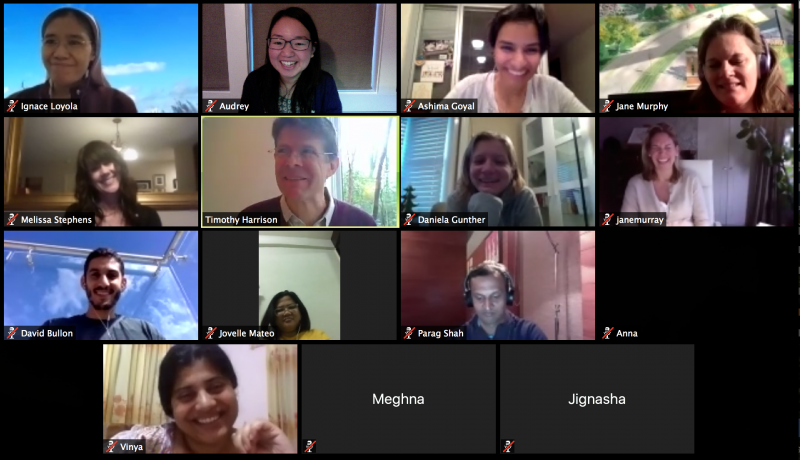Highlights From Compassion In Education Call!

What a privilege to have had the opportunity to be on the current Education Laddership Circle's breakout call on Sunday with compassion educator and researcher, Timothy Harrison, talking about the science of compassion.
That sentence can seem like an oxymoron at first hearing, but Tim was able to explain with great warmth and heart, why those two words must accompany each other as we evolve through these interesting times we live in.
The conversation opened with a quick share from the participants on what compassion means in their world, so many reflections: moments in wholeness, a mother’s love, the future...all sorts of perspectives. These reminded Tim of a story from the Buddha, when asked why compassion was important when there are so many other qualities to cultivate. The Buddha replied that in the same way that an elephant’s footprint is so large, that it can contain the footprints of every other animal, in the same way, compassion is so large that it contains all of the other qualities.
One of the standout remarks from Tim was that all human beings - all of us - have compassion as part of our design, at least in potential. Working with the 14th Dalai Lama, neuroscientists and emotion scientists - Tim and Emory university work to see if they can define compassion, research it and see if it can be grown in the individual and ultimately in the collective.
One thing they have found, is that when cultivated, compassion can become the primary response in any situation. Their work takes in the natural biases that we all have where we have certain people or situations who draw more compassion than others. The training that they offer allows for an examination of the those internal barriers and maybe start to soften what is known as a natural ‘ingroup bias’. This is not to work against our biology but to work with it to extend beyond natural bias.
Tim shares their working definition of compassion which is to see compassion as a motivation to be of help to others, or to see others free from their struggles. Part of the process is seeing someone’s struggle - which is empathy - but compassion itself is our desire or motivation to see that person free from that suffering.
Their academic program at Emory University's Center for Contemplative Science and Compassion-Based Ethics focuses on compassion to people, which he notes is actually a more challenging thing for us than say, compassion for the planet or animal kingdoms. Two trainings which Emory uses as part of their teaching and research are SEE Learning (Social, Emotional and Ethical Learning), which is for kindergarten to 12th grade and Cognitively-Based Compassion Training (CBCT) for adults.

In describing compassion further, Tim (referencing Joan Halifax’s remark that compassion is "made up of non-compassion ingredients") uses the metaphor of flowers. Compassion is like flowers in our garden, which we love, but flowers don’t occur just because we love them or like to visualise them. They grow when the right conditions are present the right co dictions to grow flowers have to be present. So going back to the original point that all human beings have compassion in potential, it requires focus to produce those flowers, despite the fact that they are natural. We can do the work in ensuring the flowers grow and that is where Tim and Emory are focussed. Their programmes, which are contemplative based, give the opportunity to look at the internal conditions which allow the flowers of compassion to bloom.
In response to a question about education and the Dalai Lama’s view of its role, Tim recalled an occasion in 1998 when the Dalai Lama spoke at Emory University's graduation. Making the point that compassion is not a luxury that we add on, its foundational to the health of society, his Holiness said that having a great education, wealth, status is not really valuable if you don’t have a warm heart. warm-heartedness, can be cultivated, we can teach children how to do it. Skills that we cultivate through education, law, medicine, engineering are wonderful but not useful if we do not also cultivate a warm heart.
Looking at the faces on the screen on Sundays call, faces from all over the world, Tim remarked that it would be easy to note how different we are. He went on to say that actually, the difference is only interesting because we are all so similar - we all wake every morning wishing for wellness wishing to be free from harm. That is what is extraordinary - how very similar we all are and that is where compassion can grow.

And, a bonus follow-up Q&A:
Does it makes sense to have a metric for measuring compassion and if so how can we do that? We have IQ (intellectual quotient) and EQ (emotional quotient), should we also have CQ (compassion quotient)? (Couple years back, some schools in California put gratitude and grit on report cards. When some of us were in school, our report cards had asection on courteousness and manners.)
Tim: I haven’t seen a really good measure of compassion yet, but it would be great to have one, you are right. I like the three dimensional wisdom scale, developed for adults. It really is covering compassion for self and others, I think. There is also a “compassionate love for humanity” scale, which is okay. These self-report scales have their limits of course. Some researchers are doing these tests but also doing “third person” evaluations where your compassion is rated by close family or colleagues.
His Holiness the Dalai Lama was asked how he would measure compassion once by a scientist. He replied that in his tradition it is said that you cannot be sure if someone is compassionate or not by observing them in short periods. You need to know them for long periods of time, say 20 years, and see how they act in many contexts. The scientist was very disappointed with this answer, as you may imagine.
Some research suggests that we may not want to grade kids on whether they are compassionate. There is research that shows that children are naturally altruistic even as early as 15 months. However, if the child is praised for being altruistic by the mother, for example: “It is so wonderful how you helped that person!”, then the child actually becomes LESS LIKELY to help the next time they get the opportunity – UNLESS they know their mother will be there to praise them again. In other words, praising someone for being compassionate (or grateful) seems like it can take what is a natural other-oriented response and turn it into something that is more self-oriented. “How wonderful I am for being compassionate!”
Now they act with kindness in order get the mother’s love, which is ultimately a self-centered motivation. Here are some very fun videos of these tests of the young children, to see how early someone can be altruistic:
And here is one of the studies by the same researchers suggesting the rewards can be counterproductive to allowing altruism to flourish.
Compassion, and gratitude, and friendliness, etc, are really their own rewards (like eating healthy foods), and it seems the best thing we can do is to create a world where children figure that out on their own, as much as possible. But that doesn’t mean they cannot be taught many things and learn to be compassionate through seeing the example of some wonderful caring teachers, such as yourself!
Posted by Jane Murray on Jan 17, 2019



On Jan 18, 2019 Ku Kahakalau wrote:
Post Your Reply